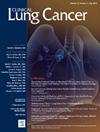The Toxicity Profile of Pemetrexed in Non-Small Cell Lung Cancer Patients With Moderate Renal Impairment: A Retrospective Cohort Study
IF 3.3
3区 医学
Q2 ONCOLOGY
引用次数: 0
Abstract
Purpose
Pemetrexed is a key drug in the immunochemotherapy of non-small cell lung cancer (NSCLC). However, its use is contraindicated in patients with renal impairment due to severe toxicity risks. As renal impairment is common in lung cancer patients, healthcare professionals face a dilemma between withholding effective treatment and risking toxicity. Real-world data on pemetrexed toxicity may aid in this decision. The primary objective of this study was to describe the toxicity profile of pemetrexed treatment in NSCLC patients with renal impairment.
Patients and methods
This multicenter, descriptive, retrospective study was conducted across 9 hospitals in the Netherlands between 2015 and 2024. Patients included had a diagnosis of NSCLC, received ≥ 1 cycle of standard dose pemetrexed, and had a baseline creatinine clearance (CrCL)<45 mL/min. Data were collected on patient and treatment characteristics, hematological and nonhematological toxicity incidences, treatment discontinuation, dose reduction, and treatment-related hospitalization.
Results
Forty-four patients were included, with median CrCL 41.1 mL/min (interquartile range: 35.0-43.9). Thirty-one patients (70%) did not finish 4 cycles of pemetrexed treatment, with 14 patients (45%) discontinuing due to pemetrexed-associated toxicity. More than half of patients (n = 28; 64%) were hospitalized due to treatment-related toxicity. Seventeen patients (39%) developed grade 3-4 neutropenia and leukopenia. Gastro-intestinal toxicity grade 3 to 4 occurred in fifteen (34%) patients.
Conclusion
Pemetrexed treatment of NSCLC patients with moderate renal impairment was associated with high incidence of hematological toxicity, hospitalization, dose reduction, and treatment discontinuation. These results highlight the necessity of developing new treatment regimens to enable safe pemetrexed-based immunochemotherapy in NSCLC patients with renal impairment.
培美曲塞对中度肾功能损害的非小细胞肺癌患者的毒性:一项回顾性队列研究。
目的:培美曲塞是非小细胞肺癌(NSCLC)免疫化疗的关键药物。然而,由于严重的毒性风险,它的使用禁忌于肾功能损害患者。由于肺癌患者肾脏损害很常见,医疗保健专业人员面临着拒绝有效治疗和冒毒性的两难境地。培美曲塞毒性的真实数据可能有助于这一决定。本研究的主要目的是描述培美曲塞治疗肾损害的非小细胞肺癌患者的毒性。患者和方法:这项多中心、描述性、回顾性研究于2015年至2024年间在荷兰的9家医院进行。纳入的患者诊断为NSCLC,接受标准剂量培美曲塞≥1个周期,基线肌酐清除率(CrCL)结果:纳入44例患者,中位CrCL为41.1 mL/min(四分位数范围:35.0-43.9)。31例患者(70%)未完成培美曲塞治疗4个周期,14例患者(45%)因培美曲塞相关毒性而停止治疗。超过一半的患者(n = 28;64%)因治疗相关毒性而住院。17例(39%)出现3-4级中性粒细胞减少和白细胞减少。15例(34%)患者出现3 - 4级胃肠道毒性。结论:培美曲塞治疗中度肾功能损害的NSCLC患者与血液学毒性、住院、剂量减少和停药的高发相关。这些结果强调了开发新的治疗方案的必要性,以便在肾损害的非小细胞肺癌患者中实现安全的培美曲塞免疫化疗。
本文章由计算机程序翻译,如有差异,请以英文原文为准。
求助全文
约1分钟内获得全文
求助全文
来源期刊

Clinical lung cancer
医学-肿瘤学
CiteScore
7.00
自引率
2.80%
发文量
159
审稿时长
24 days
期刊介绍:
Clinical Lung Cancer is a peer-reviewed bimonthly journal that publishes original articles describing various aspects of clinical and translational research of lung cancer. Clinical Lung Cancer is devoted to articles on detection, diagnosis, prevention, and treatment of lung cancer. The main emphasis is on recent scientific developments in all areas related to lung cancer. Specific areas of interest include clinical research and mechanistic approaches; drug sensitivity and resistance; gene and antisense therapy; pathology, markers, and prognostic indicators; chemoprevention strategies; multimodality therapy; and integration of various approaches.
 求助内容:
求助内容: 应助结果提醒方式:
应助结果提醒方式:


